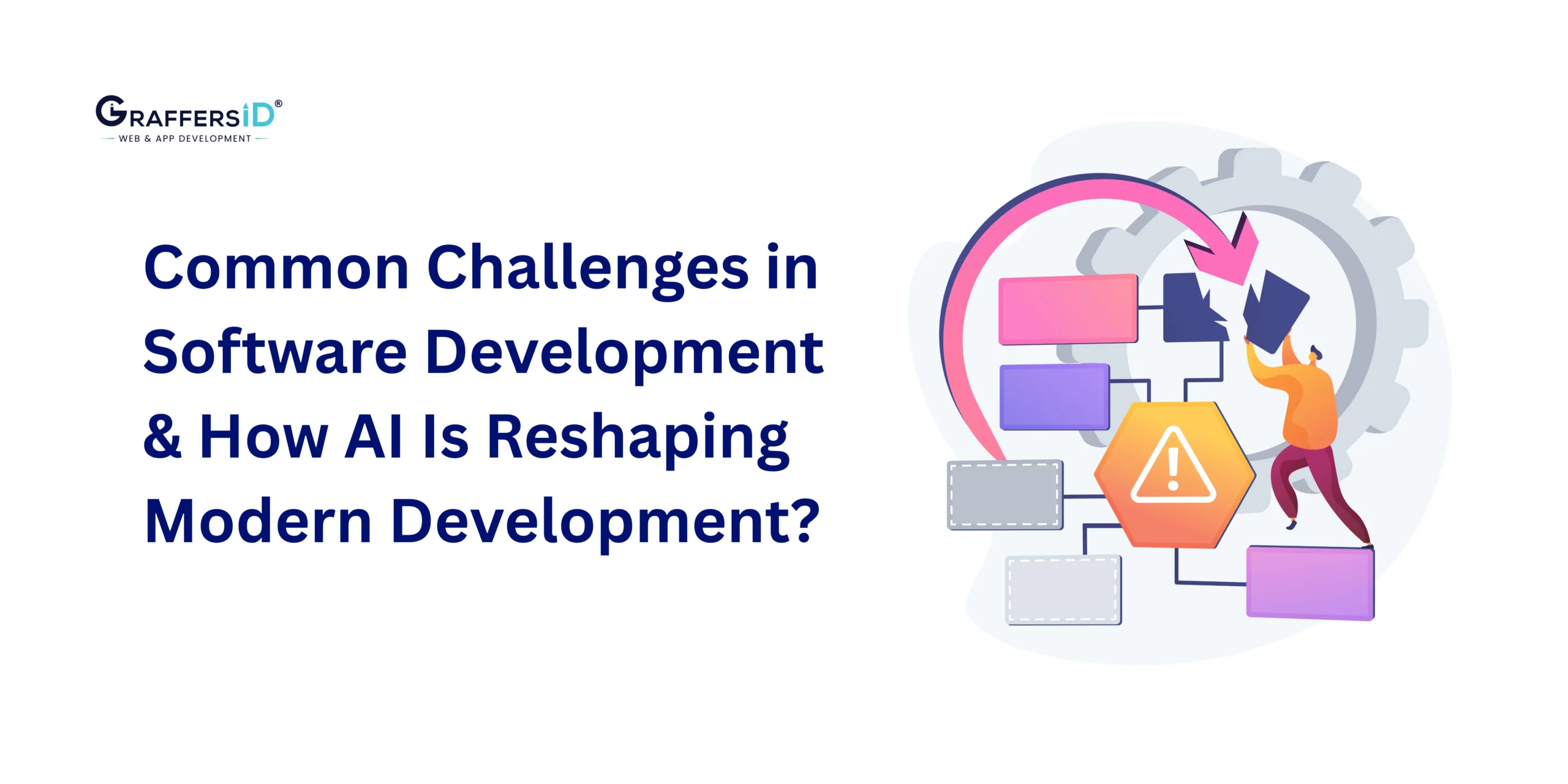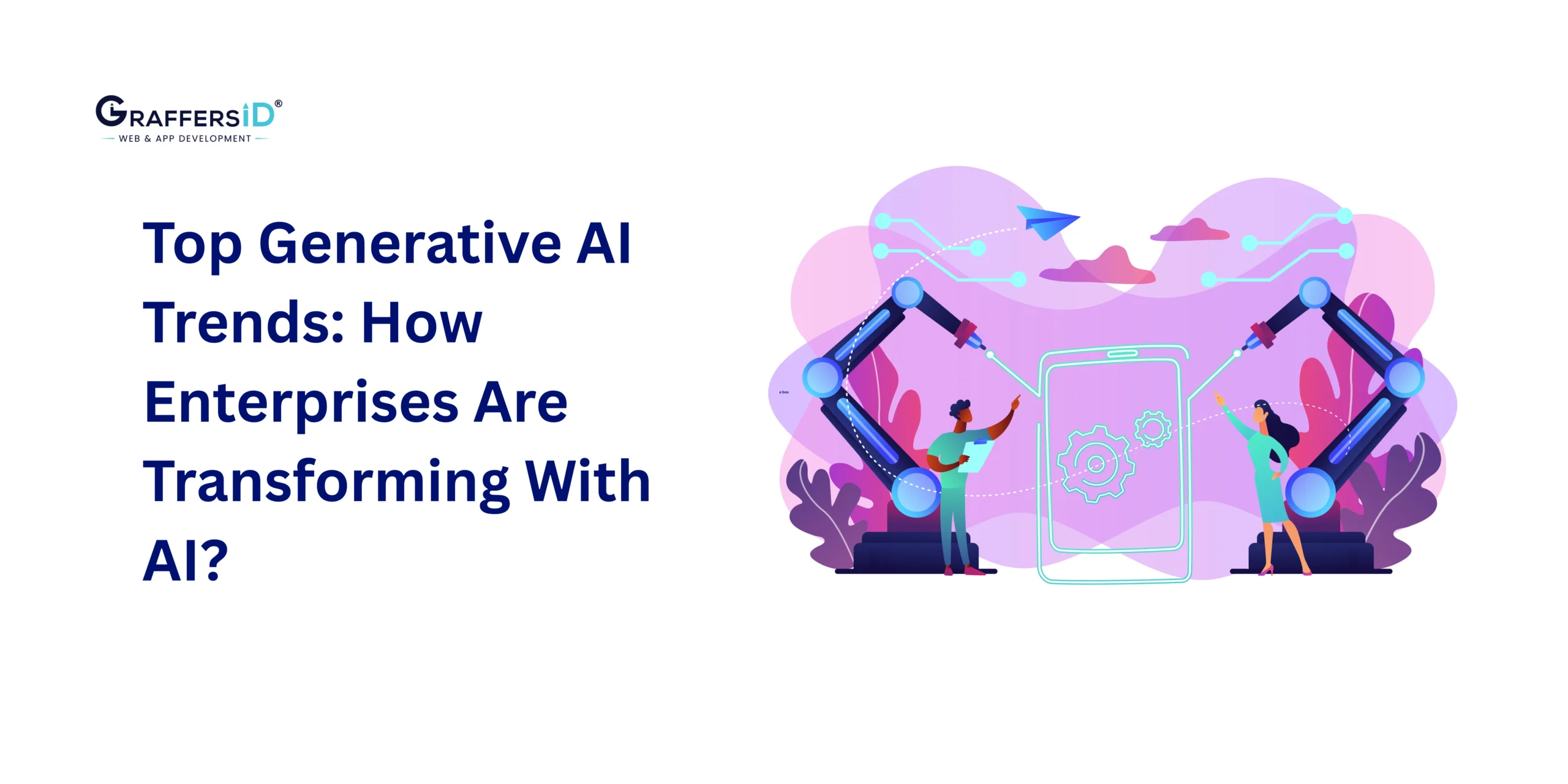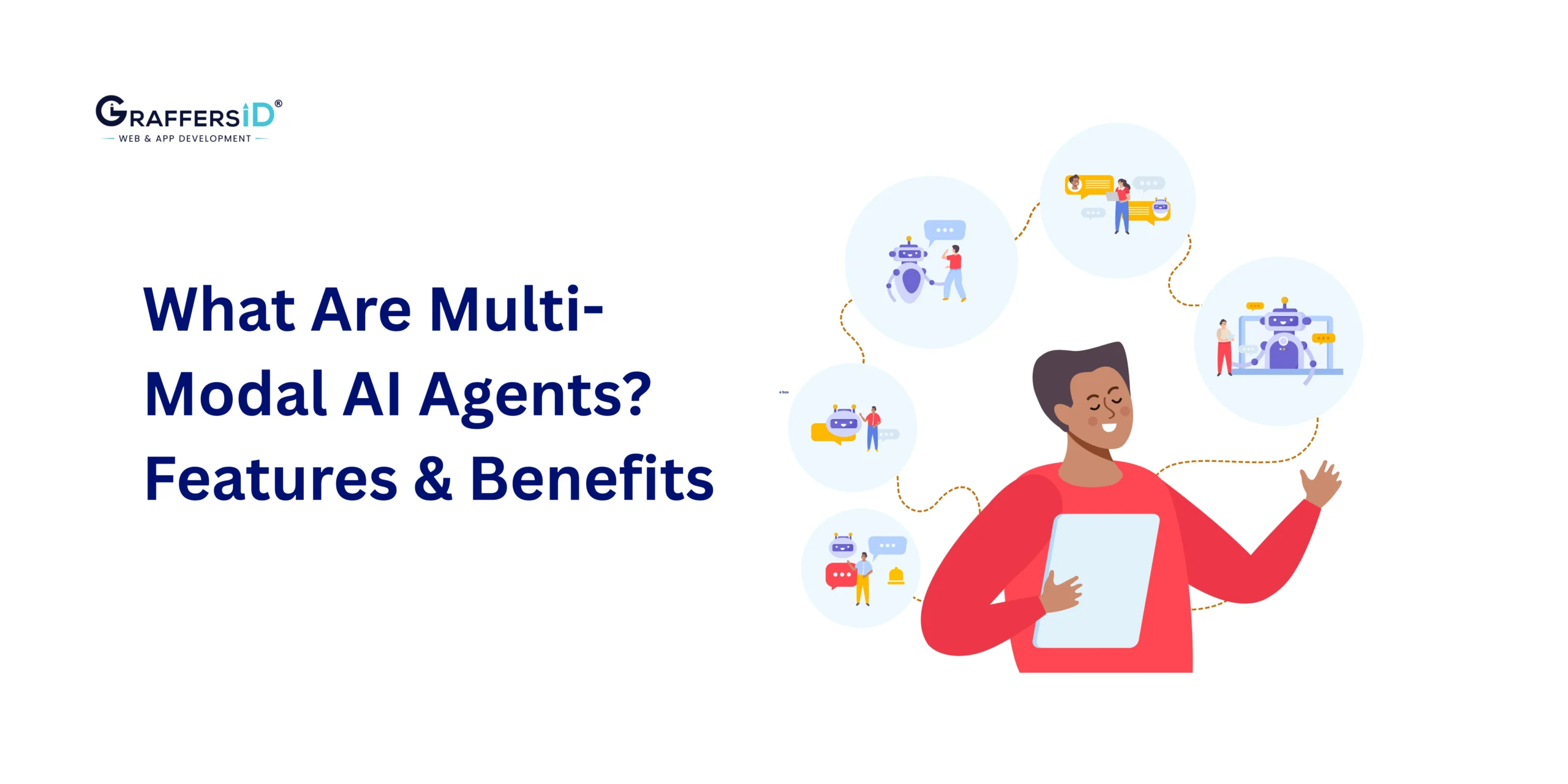Software development in 2026 is no longer just about writing efficient code; it’s about engineering intelligent, adaptive, and future-ready systems that can evolve with business needs. From AI integration and automation pipelines to secure, cloud-native architectures, the development landscape has become faster, smarter, and more complex than ever.
Yet even with advanced tools like AI coding assistants, DevOps automation, and predictive project management, teams still struggle with age-old, and now AI-enhanced, challenges: unclear requirements, integration bottlenecks, skill gaps, and data security concerns.
In this 2026 guide, we’ll uncover the most common challenges in modern software development, how AI and automation are reshaping them, and the actionable strategies leading tech companies use to overcome them.
Common Challenges in Software Development (2026 Overview)
Despite advancements in AI, automation, and cloud-native architectures, software teams in 2026 continue to face recurring challenges that impact quality, timelines, and scalability. Below are the five most common challenges shaping the modern development landscape:
-
Project Management Challenges: Managing hybrid teams, changing requirements, and AI-driven workflows.
-
Technical Challenges: Handling integration, scalability, security, and technical debt in multi-stack environments.
-
Team Collaboration and Skill Gaps: Balancing remote work, AI adoption, and evolving developer expertise.
-
Time and Budget Constraints: Delivering high-quality software within limited resources and tight deadlines.
-
Quality Assurance and Testing Challenges: Ensuring reliability, accuracy, and performance in AI-augmented systems.
Each of these challenges requires a modern, AI-driven approach to stay competitive in 2026, and in the sections below, we’ll explore how to overcome them with practical, actionable strategies.
Read More: Role of Artificial Intelligence (AI) in Software Development
1. Project Management Challenges
Project management remains the basis of successful software delivery. However, in 2026, managing hybrid teams, aligning AI-driven workflows, and handling dynamic requirements have become more complex than ever.
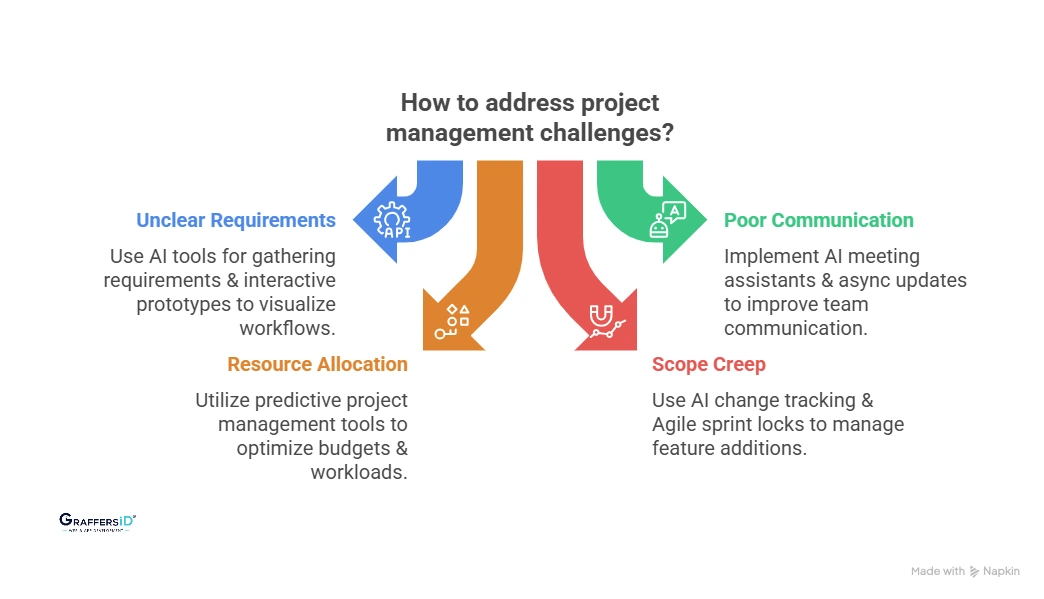
Common Project Management Challenges
| Challenge | Description | Solution |
|---|---|---|
| Unclear Requirements | Stakeholders fail to define precise outcomes, especially for AI-driven projects. | Use AI-powered requirement gathering tools and visualize workflows using interactive prototypes (e.g., Figma AI, Lucidchart). |
| Poor Communication | Miscommunication between distributed teams causes costly delays. | Use AI meeting assistants (e.g., Notion AI, Otter.ai) for summaries and async updates via Slack or Jira. |
| Resource Allocation | Misaligned budgets and workloads create burnout or idle capacity. | Use predictive project management tools like Monday.com AI or ClickUp Brain to optimize workloads. |
| Scope Creep | Frequent feature additions derail timelines. | Implement AI-driven change tracking and use Agile sprint locks to manage evolving scopes. |
Key Takeaways
- Prioritize transparent stakeholder alignment from day one.
- Integrate AI project tracking tools for visibility and accountability.
- Use Agile sprints with clear deliverables to control evolving project scopes.
2. Technical Challenges
Technical challenges have become more intricate as teams adopt microservices, cloud platforms, and AI integrations. Ensuring smooth performance, scalability, and security is now a multidisciplinary effort.
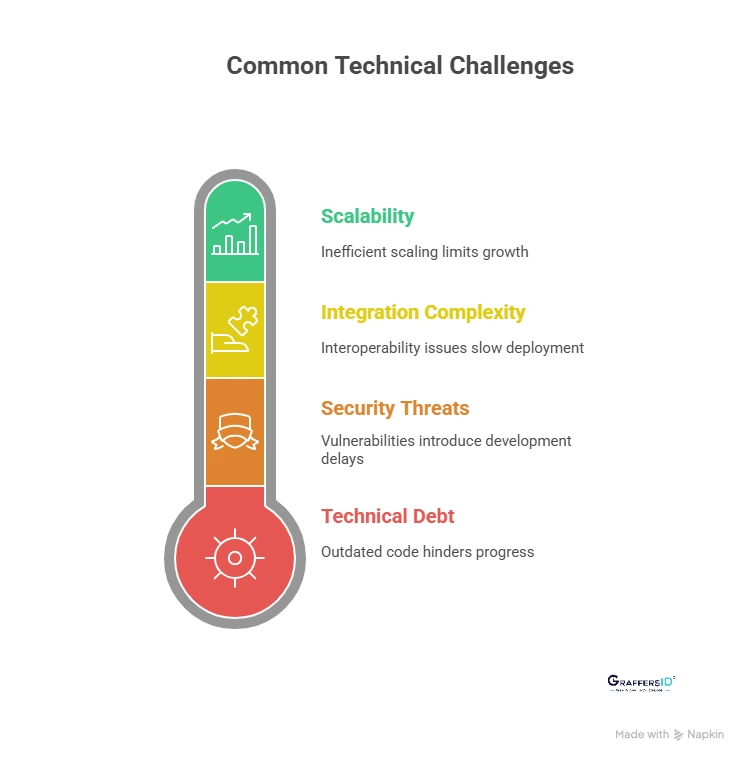
Common Technical Challenges in 2026
| Challenge | Description | Solution |
|---|---|---|
| Integration Complexity | AI APIs, legacy systems, and third-party platforms create interoperability hurdles. | Adopt standardized APIs, use GraphQL, and automate API testing with Postman AI. |
| Scalability | Apps struggle to scale efficiently under data-heavy or real-time workloads. | Implement serverless architectures and container orchestration (e.g., Kubernetes, AWS Lambda). |
| Security Threats | AI systems introduce new vulnerabilities (e.g., prompt injection, data leakage). | Enforce AI security frameworks (OWASP for LLMs) and zero-trust architectures. |
| Technical Debt | Outdated code slows innovation. | Use AI code reviewers (like GitHub Copilot Enterprise) and schedule regular refactoring sprints. |
Key Takeaways
- Adopt AI-assisted DevOps to improve release velocity and stability.
- Implement continuous testing and monitoring pipelines for early error detection.
- Ensure data privacy and compliance (GDPR, SOC 2) in AI-based products.
3. Team Collaboration and Skill Gaps
With distributed teams and AI adoption, collaboration now extends across time zones, collaboration tools, and intelligent systems. The biggest challenges in 2026 involve upskilling, ownership, and human-AI collaboration.
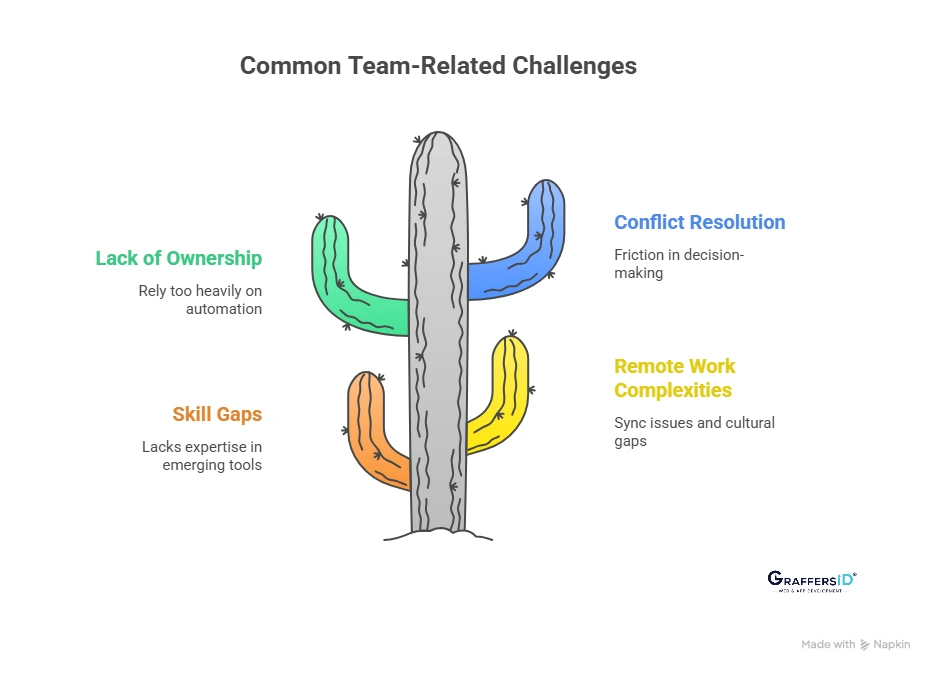
Common Team-Related Challenges
| Challenge | Description | Solution |
|---|---|---|
| Skill Gaps | Developers lack expertise in emerging tools like AI frameworks or LLM integration. | Offer AI bootcamps or partner with offshore experts from India for cost-effective talent. |
| Remote Work Complexities | Teams across geographies face sync issues and cultural gaps. | Use AI-driven collaboration tools (e.g., Miro AI, Zoom Intelligent Companion) to bridge gaps. |
| Lack of Ownership | Team members may rely too heavily on automation. | Foster human-AI balance, assigning clear responsibilities alongside AI tools. |
| Conflict Resolution | AI recommendations may cause friction in decision-making. | Encourage AI transparency and use data-backed insights for neutral resolution. |
Key Takeaways
- Invest in AI literacy and cross-training programs.
- Encourage collaborative decision-making between humans and AI tools.
- Define accountability frameworks that maintain human oversight in automation-heavy workflows.
Read More: What is Generative AI and How It’s Transforming Software Development in 2026?
4. Time and Budget Constraints
As AI speeds up development, clients and stakeholders expect faster delivery at lower costs, but speed often challenges quality. Efficiently balancing deadlines, budgets, and innovation is a 2026 necessity.
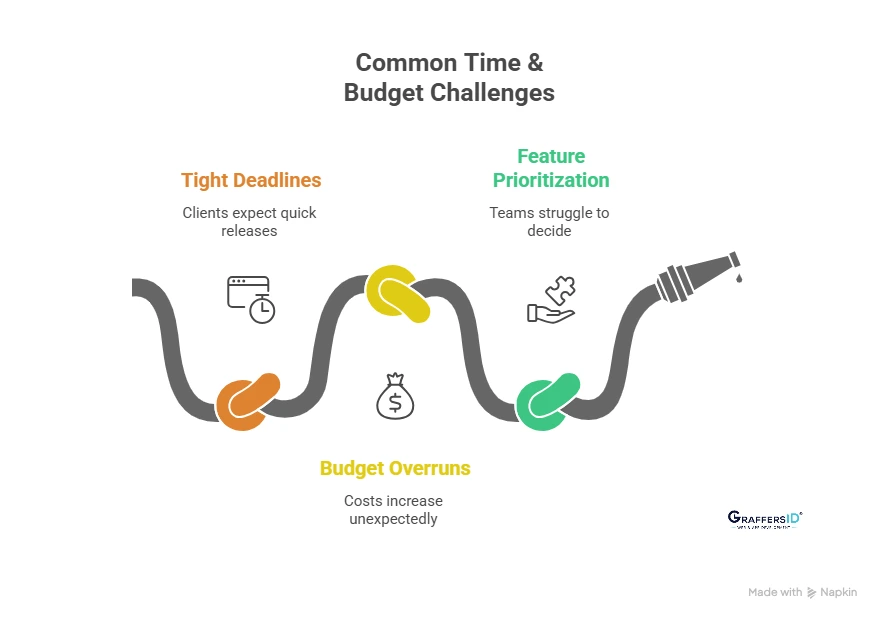
Common Time and Budget Challenges
| Challenge | Description | Solution |
|---|---|---|
| Tight Deadlines | Clients expect AI-enabled apps within weeks. | Use AI code generators and MVP-first delivery models to accelerate releases. |
| Budget Overruns | Costs increase due to constant AI API usage or cloud scaling. | Adopt usage monitoring tools (e.g., CloudZero, FinOps platforms) to control expenses. |
| Feature Prioritization | Teams struggle to decide what to build first. | Use AI prioritization models (based on ROI and user sentiment analytics). |
Key Takeaways
- Embrace Agile + AI-assisted development cycles for flexible delivery.
- Set realistic sprint budgets and use predictive analytics for cost forecasting.
- Prioritize features based on business impact, not assumptions.
5. Quality Assurance and Testing Challenges
As applications integrate AI and automation, traditional testing approaches fall short. Ensuring software reliability, accuracy, and ethical compliance now requires AI-powered QA pipelines.
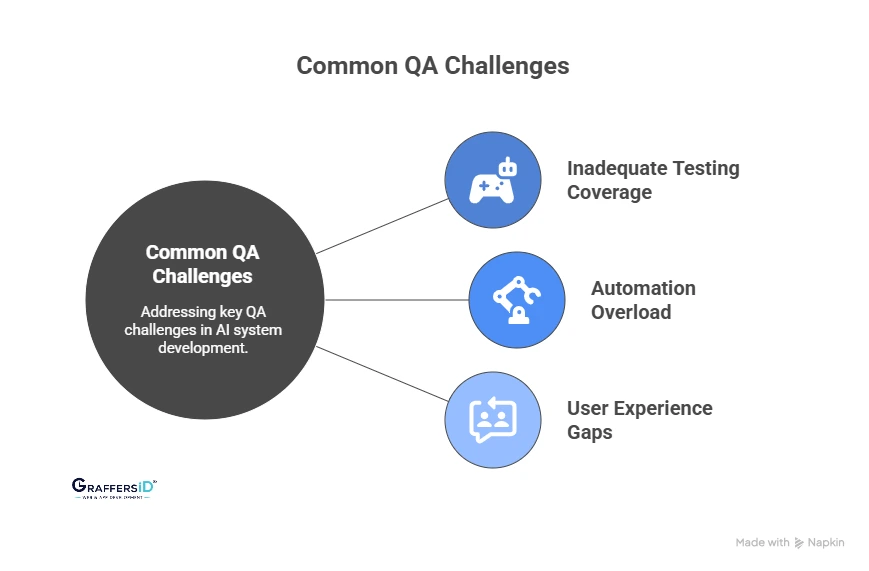
Common QA Challenges
| Challenge | Description | Solution |
|---|---|---|
| Inadequate Testing Coverage | Manual testing misses edge cases in dynamic AI systems. | Deploy AI test generators and run automated regression testing. |
| Automation Overload | Poorly trained test bots generate false positives. | Continuously train and validate test AI models with real-world data. |
| User Experience Gaps | AI models may produce inconsistent UX responses. | Conduct human-centered AI testing with real users and behavior analytics. |
Key Takeaways
- Combine human intuition testing with AI-powered test automation.
- Use AI observability tools (like Datadog AI and New Relic) for continuous monitoring.
- Involve users early in the feedback loop for adaptive design improvements.
Conclusion
Software development in 2026 is no longer about avoiding challenges; it’s about leveraging them to innovate, scale, and lead. The rise of AI-driven project management, automation-first workflows, and predictive analytics has redefined how teams plan, build, and deploy software.
Organizations that embrace these changes can reduce delivery timelines, enhance product quality, and stay resilient in a rapidly evolving digital market. The key is adopting intelligent systems, continuous learning, and collaborative AI practices that turn obstacles into strategic advantages.
At GraffersID, we help startups and enterprises hire pre-vetted AI developers, build scalable web and mobile applications, and integrate automation-driven workflows tailored to your business goals.
Our team of AI and software development experts from India delivers cost-effective, high-quality solutions trusted by global brands.
Ready to overcome development challenges with expert support? Hire remote AI developers from GraffersID today!
